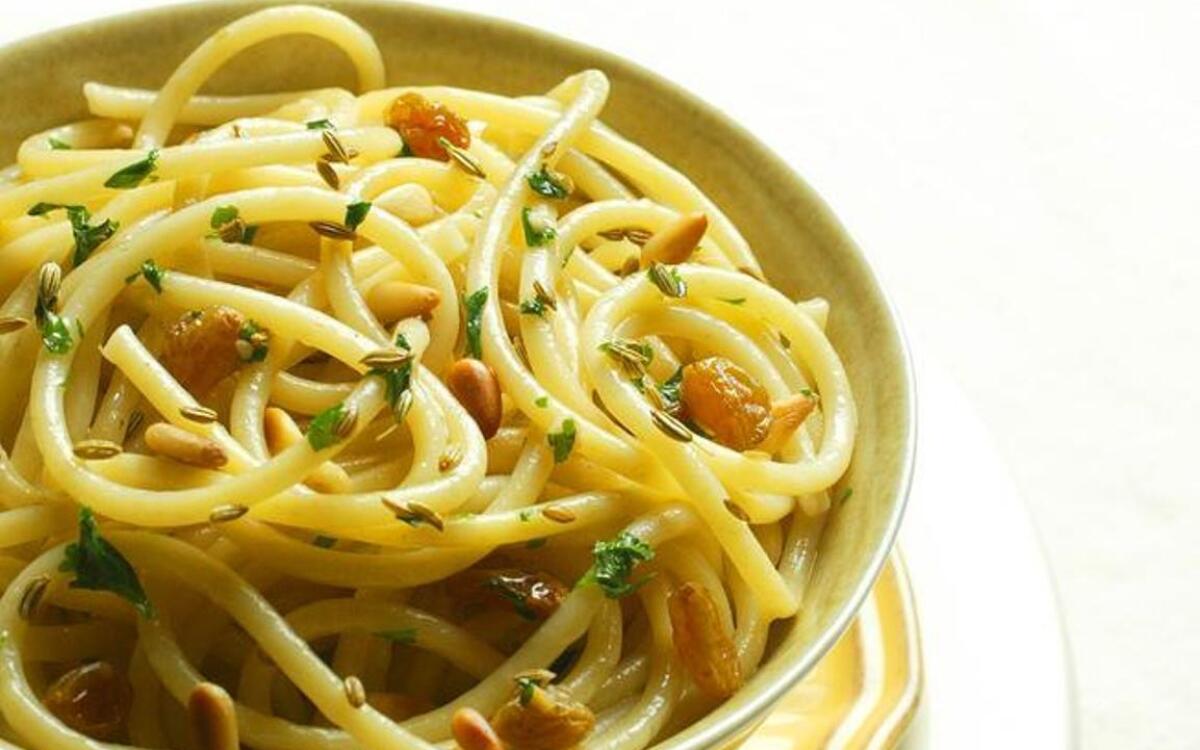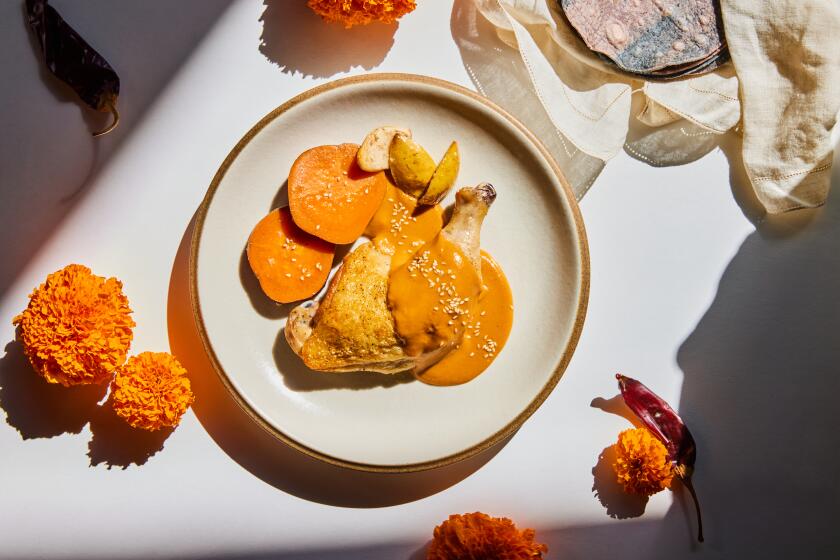Bucatini with golden raisins, fennel and pine nuts

I’m standing on a bluff overlooking the ocean, soaking up the afternoon sunshine. It’s that delicious warm part of a fall day when the chill of the morning fog has burned off but before it can creep back for the evening. Below me, the sea cracks against a rocky beach. Catalina looks like it’s about a block away. In my hand, I hold a brown paper bag full of just-picked fennel pods. Their warm perfume mingles with the fresh salt air. And all I can think about is dinner.
What about heating some of the seeds in olive oil and drizzling it over grilled fish? I think. About one-fourth to one-half teaspoon for a cup of oil would be just about right.
Or I could warm them in honey and spoon them over sliced pears and shards of Parmigiano-Reggiano. Same proportions will work.
Hey, what about mixing the seeds into little pork-and-veal meatballs and cooking them in tomato sauce? Or poaching the seeds with some fish in white wine so when the liquid cools it will form a beautifully perfumed jelly? Oh, I know, I’ll stew them quickly with anchovies, golden raisins and pine nuts to make a sauce for chewy bucatini pasta.
Give me another couple of hours to stand here and I’ll come up with more.
I know a spot where the wild fennel grows, and I’ll bet you do too. In fact, if you’ll open your eyes, it’s almost everywhere in Southern California. It’s found up and down the state, from San Diego to Humboldt County. A Mediterranean plant introduced by farmers, it propagates like mad and can be found wherever the climate is right. Though it seems to have adopted California as a second home, fennel is also found in states from Florida to Wisconsin.
Unlike the stuff you buy in the grocery stores, the bulb of the wild fennel is beside the point. It’s thin, stringy and mean. But in the spring, fennel sends up vibrant green sprays of fronds that are almost impossibly fragrant when stuffed into the belly of a baked fish, or when strewn across a hot bowl of boiled favas.
And at this time of year, even after the fronds have died back to nothing and the stalks have turned brown and crackly, fennel plants are laden with starbursts of tiny, explosively pungent seeds that add a green, anise-flavored exclamation point to all kinds of dishes.
These fennel seeds are different from the ones you buy in the grocery store. In the first place, they’re smaller. But they’re more tender too; they pop rather than crunch.
And the flavor ... the only thing to compare it to is those little spoonfuls of candied fennel seeds you get after dinner at Indian restaurants. They’re impossibly sweet with a mouth-filling anise flavor. (Remember this when cooking with them: a little bit goes a long way. In a pinch, you can use regular fennel seeds but the flavor won’t be as dramatic.)
When you’re cooking with wild fennel, you’ll almost invariably wind up with something that seems to be at least vaguely Italian. Though wild fennel is found all over Italy, oddly enough the seeds are little used. Italians seem to favor the green fronds, which show up in such things as pasta chi sardi, the signature Sicilian dish of spaghetti, fresh sardines and fresh fennel. There is also a pretty wonderful pesto made with wild fennel fronds.
The pollen of wild fennel, which must be gathered in the spring, is one of the ingredients of the moment in restaurant cooking. If you’re feeling really ambitious along about May or June, collect the flowers, then sort and screen them to separate the pollen. Do it once and you’ll understand the $25-per-ounce price.
Wild fennel grows almost everywhere. I remember walking through a particularly bleak part of downtown L.A. and catching a familiar scent. There, on a rocky patch of ground just above a parking lot was a magnificent stand of fennel. Of course, I wouldn’t advise collecting seeds from street fennel. You’ll want to gather them from plants that grow off the beaten track, away from chemical sprays, auto exhaust, walking dogs and other pollutants.
It may be my imagination, but I find the most fragrant fennel seems to grow within sight of the water. This place I was telling you about, for example -- I have to lean clear out over the fence to get to the seeds.
Though they may look unpromising, search for plants that have died back so that just the stalks remain. This isn’t hard; we’re not talking about ankle-high dandelions here. Fully grown fennel stalks can be taller than a man. The seed clusters will be at the tops of the stalks, looking like connect-the-dots versions of tiny umbrellas (fennel belongs to the family Umbelliferae, so named because of this pattern).
Choose clusters with seeds that are fully formed but not yet hardened. Pull them off and stick the clusters in a paper bag. When you’ve got enough, take them home to sort. The back of a knife works well to separate the seeds from the pods and tiny stems. You can use them right away. Whatever’s left over (and there will be a bunch -- one trip is usually enough to supply a winter), set out to dry. They’ll keep forever in a tightly sealed container.
I’ve found it always pays to taste a couple of seeds before investing much effort in picking. Just last week, I was picking seeds in what seemed to be a long-vacant parking lot near the ocean. When I sampled a couple of seeds, my mouth went numb. Chemical herbicidal sprays are used in the oddest places.
Some misguided souls, it seems, are out to eradicate fennel. One of my favorite spring fennel stands is always gone by late summer -- mowed down as a fire hazard. In fact, fennel is officially classified as an invasive pest.
Actually, that’s about as good a definition as I can imagine of the magic of California -- a state where even the weeds are delicious.
Harvesting fennel
Wild fennel can be found all over California. Here’s what to look for:
Fully grown plants have the best seeds. They’ll look almost dead, like a collection of tall, dried stalks. Choose plants that have grown away from well-traveled paths. Taste a few seeds before harvesting.
To collect seeds, pull whole clusters from the tops of the stalks. Separate seeds from stems and husks at home. Seeds can be used immediately or dried overnight in a cool oven. Stored in a jar, they’ll last forever.
Cover the raisins with hot water and let soften 15 to 20 minutes.
Warm the olive oil, garlic, anchovies and fennel seeds in a skillet over medium-low heat. After about 5 minutes, the garlic and anchovies will begin to melt into a fairly smooth paste. Add the parsley and keep the mixture warm, but do not let the garlic scorch.
Cook the bucatini in plenty of rapidly boiling, salted water until it is tender, about 10 minutes. Drain the bucatini, reserving 1/2 cup of the pasta cooking water, and add the noodles to the skillet with the sauce. Drain the raisins and add to the skillet. Increase the heat to high and add the reserved pasta cooking water. Cook, stirring the mixture together, until most of the water has evaporated and the sauce clings to the noodles, about 3 minutes. Stir in the pine nuts. Serve immediately.
Get our Cooking newsletter.
Your roundup of inspiring recipes and kitchen tricks.
You may occasionally receive promotional content from the Los Angeles Times.
















